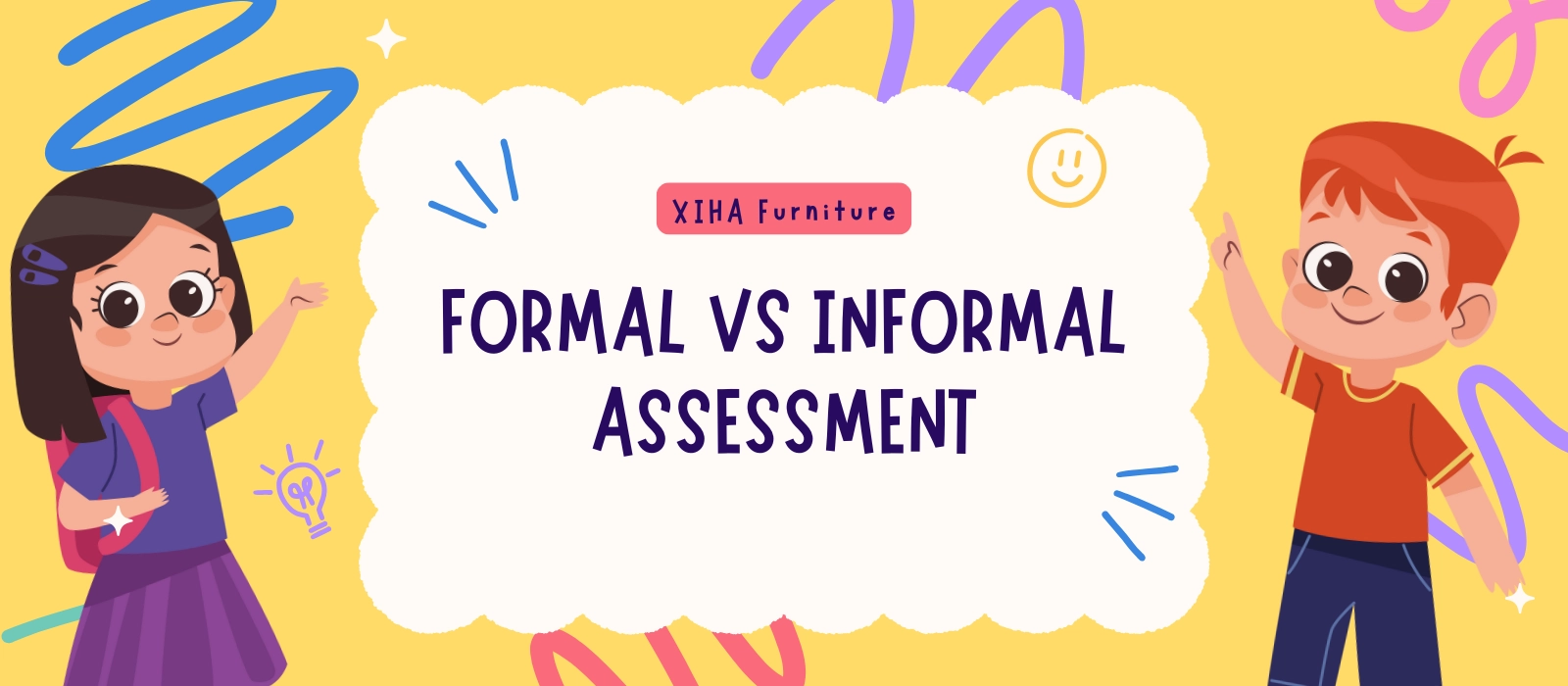Introduction: Do Parents and Educators Truly Understand the Difference?
Are you worried that your current classroom assessments might not reflect your children’s true learning? Do you feel lost between test scores and teacher observations? Are you unsure how to choose between formal vs informal assessment for your kindergarten?
In early childhood education, choosing between formal vs informal assessment isn’t about picking a side—it’s about understanding their roles. Formal assessments provide objective data that supports curriculum planning and accountability. Informal assessments offer real-time insights that help personalize learning. When combined wisely, they give educators a fuller picture of each child’s development and ensure no learning opportunity is missed.
This article will help you break through the confusion with a clear comparison, plenty of examples, and expert guidance.
What Is Assessment in Early Childhood Education?
Assessment in early childhood education refers to the intentional process of collecting, analyzing, and using information to understand and support a child’s growth and learning. Unlike assessments in older grades, early childhood assessment focuses on a child’s development in multiple domains—cognitive, social-emotional, language, and physical.
At its core, assessment is not about labeling or ranking children. Instead, it is a continuous, cyclical process that involves observing what children do, documenting their actions and expressions, reflecting on what these behaviors mean, and then using that understanding to guide instruction and family communication.
High-quality assessment helps:
- Identify each child’s strengths and areas for growth
- Tailor curriculum and activities to meet individual learning needs
- Track progress over time to ensure developmental milestones are met
- Detect early signs of learning delays or challenges
- Foster strong communication between teachers and parents
There are various types of assessment used in early education, including both formal and informal methods, as well as formative (ongoing) and summative (conclusive) assessments. A well-balanced assessment system empowers educators with the right information at the right time to make child-centered decisions that optimize learning.
In practice, this might mean observing a child during play to see how they interact with peers, using a checklist to monitor language development milestones, or conducting a portfolio review to evaluate progress over several weeks. Regardless of the tool or technique, the ultimate goal is the same: to support every child’s unique developmental journey.
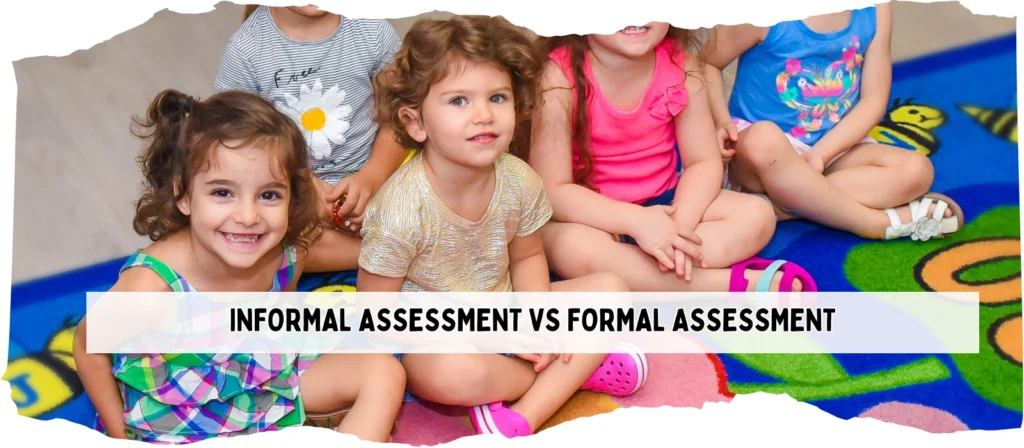
What Is Formal Assessment?
Formal assessment refers to structured and standardized methods used to evaluate children’s skills or knowledge in a consistent manner. These assessments are typically designed with specific scoring systems, test criteria, and performance benchmarks. Formal assessments are preplanned and follow consistent procedures for administration and scoring.
These tools are typically used to:
- Measure how much a child has learned at the end of an instructional period
- Compare a child’s performance against established standards or peers
- Identify areas where a child might need additional support or enrichment
- Document progress for policy or reporting requirements
Formal assessment helps educators and administrators gather quantifiable data that informs decision-making and accountability.
1) Structured Tools with Clear Benchmarks
Formal assessments use predetermined criteria and scoring rubrics. This structure ensures every child is measured against the same developmental expectations, allowing fair comparisons and consistent documentation. These tools are often aligned with national or regional early learning standards.
2) Common Types of Formal Assessment in Early Childhood
While standardized tests are a well-known example, other formal assessments include progress report cards, developmental checklists, and digital or physical portfolios with fixed evaluation criteria. These assessments are scheduled in advance and administered with minimal variation.
3) Objective Data for Tracking and Reporting
A key benefit of formal assessments is their ability to produce measurable data. Whether tracking literacy milestones, cognitive growth, or motor development, the results serve as a foundation for instructional planning, parent communication, and educational accountability.
4) Limitations to Consider
Despite their value, formal assessments may not always reflect the full range of a child’s capabilities—especially in a playful, exploratory learning environment. They may cause stress for young children and overlook developmental subtleties. Therefore, formal assessments work best when balanced with informal methods.
Formal assessment, when applied thoughtfully, becomes a powerful lens through which educators understand learning patterns, adjust teaching strategies, and communicate effectively with families.
What Is Informal Assessment?
Informal assessment involves observing and documenting children’s learning during everyday activities. It’s often spontaneous, flexible, and integrated naturally into the teaching process. Teachers use it to gather immediate, actionable insights that support individualized instruction.
1) Integrated into Daily Classroom Routines
Unlike formal assessments, informal assessments happen organically during play, transitions, conversations, or art activities. Educators observe how a child interacts, solves problems, or responds to challenges—without the child even realizing they are being evaluated.
2) Tools and Techniques Teachers Use
Typical informal tools include anecdotal records, sticky notes, voice recordings, or photo documentation. Teachers may jot down quick observations or compile a running log of developmental cues. Learning portfolios, though more structured, can also be informal when used flexibly.
3) Real-Time Feedback to Guide Learning
The strength of informal assessment lies in its immediacy. Teachers can adapt activities on the spot, support social-emotional learning, or extend a lesson based on a child’s engagement level. It offers a window into not just what a child knows, but how they learn.
4) Capturing Developmental Nuance
Informal assessments help reveal aspects of learning that standardized tests often miss—like persistence, curiosity, empathy, or emerging leadership. These moments are critical in preschool settings and are best documented through ongoing, narrative-based observations.
When used systematically, informal assessment empowers educators to respond to children’s needs in the moment, support developmental progress, and maintain a responsive, child-centered learning environment.
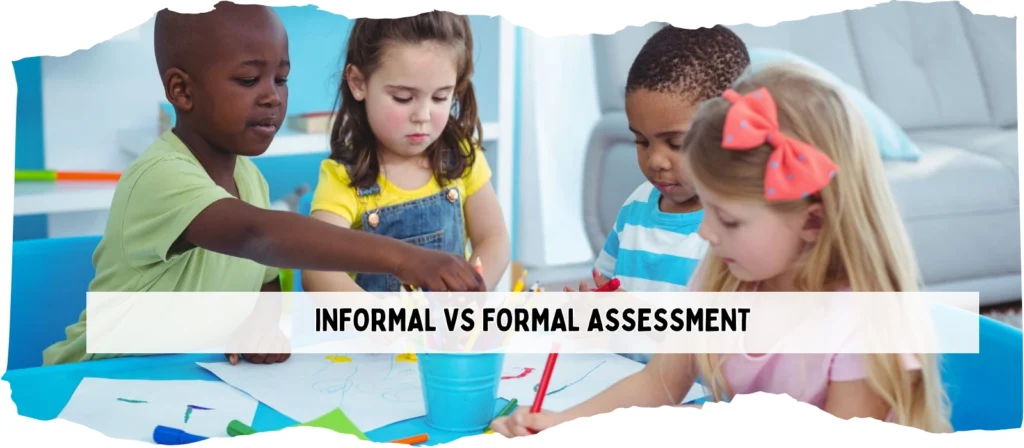
Key Differences Between Formal and Informal Assessment
1) Structure and Format
Formal vs informal assessment differs significantly in structure. Formal assessments are structured, pre-planned, and scored with standardized methods. Informal assessments, on the other hand, are fluid and naturally embedded in daily classroom routines.
2) Purpose and Goals
The goal of formal assessment is often to gather data for benchmarking or reporting. In contrast, informal assessment aims to guide instruction, provide ongoing feedback, and adapt learning strategies in real-time.
3) Data Type and Interpretation
Formal assessments provide quantitative data—scores, levels, percentiles. Informal assessments produce qualitative data such as teacher observations, student behavior patterns, and engagement levels. Together, they complement each other to offer a balanced view of child development.
4) Frequency and Flexibility
Formal assessments are typically conducted at specific points (e.g., end of term), while informal assessments occur continuously throughout the day. This flexibility allows informal assessments to capture rich, contextual insights that formal methods may miss.
Summary Table: Comparing Formal vs Informal Assessment
| Feature | Formal Assessment | Informal Assessment |
|---|---|---|
| Structure | Highly structured, pre-planned | Flexible, integrated into daily activities |
| Tools | Tests, scales, checklists | Observation, portfolios, conversations |
| Scoring | Standardized, quantifiable | Qualitative, descriptive |
| Purpose | Reporting, benchmarking, compliance | Instructional support, individualized learning |
| Frequency | Periodic (e.g., term-end) | Continuous |
| Perspective | External evaluator friendly | Teacher and child-centered |
The comparison of formal vs informal assessment reveals that neither approach is inherently better. Instead, when used together, they form a powerful strategy for understanding and supporting the diverse needs of preschool learners.
Benefits of Formal Assessments in Kindergarten
Formal vs informal assessment is a critical decision point in designing a reliable, effective learning environment for young children. When considering the benefits of formal assessments specifically, we must recognize their vital role in establishing educational consistency, measuring standards, and delivering actionable insights that serve both children and institutions.
1) Establishing Benchmarks and Learning Standards
Formal assessments allow educators to align their classroom instruction with state or national learning standards. This alignment ensures that kindergarten programs remain consistent, equitable, and goal-oriented. Through these structured tools, teachers can identify whether children are meeting age-appropriate milestones in literacy, numeracy, motor skills, and language development.
In international and multicultural environments, formal assessments are also crucial for ensuring that learners from diverse backgrounds receive equal academic opportunities, despite differences in home language or learning pace. These tools offer a universal language of evaluation, fostering a shared understanding of progress.
2) Identifying At-Risk Learners Early
One of the greatest advantages of formal assessment is its predictive power. Standardized screenings and diagnostic tools can detect early signs of developmental delays, learning difficulties, or behavioral concerns. When these issues are identified early, intervention strategies can be deployed in time to prevent long-term academic challenges.
Formal vs informal assessment comparisons consistently show that formal methods are better suited for flagging these high-priority concerns early, particularly when used in conjunction with health screenings or parental feedback.
3) Supporting Communication with Families and Authorities
Parents, administrators, and regulatory bodies often require formal reports to understand a child’s developmental trajectory. Formal assessments provide clear, data-driven summaries that can be shared during parent-teacher conferences or submitted for compliance with local education authorities.
When parents ask, “How is my child doing compared to others?” or “Is my child ready for first grade?”, the objective nature of formal assessment results provides answers with credibility and clarity. In this context, formal vs informal assessment becomes more than a teaching decision—it becomes a trust-building mechanism with families.
4) Evaluating Program Effectiveness
Educators and school leaders also use formal assessment data to evaluate the effectiveness of their curriculum, teaching methods, and resource allocation. Trends in standardized scores or developmental checklists can highlight whether certain teaching practices are successful—or if instructional changes are needed.
In a B2B preschool setting, especially for international procurement professionals or kindergarten directors purchasing educational solutions, formal vs informal assessment outcomes also guide resource investment and teacher training decisions.
Formal assessments may not capture every nuance of a child’s day-to-day progress, but their ability to organize, summarize, and validate performance across a group of learners makes them indispensable in a structured educational environment.
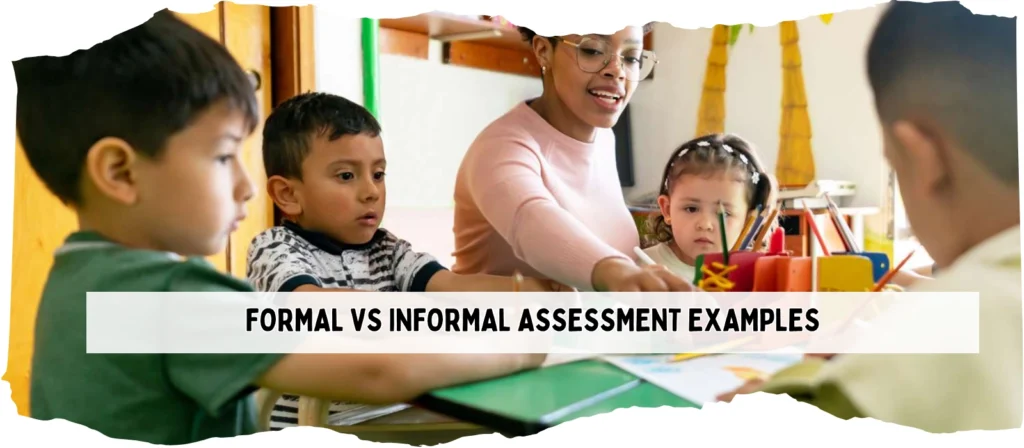
Benefits of Informal Assessments in Kindergarten
When debating formal vs informal assessment in preschool settings, it’s important to highlight that informal assessments offer equally powerful advantages. Especially in environments focused on play-based or exploratory learning, informal assessment becomes a natural and effective tool to understand each child’s needs, strengths, and growth areas.
1) Enhancing Responsiveness in Teaching
Informal assessments allow teachers to immediately adapt their teaching strategies to a child’s observed needs. Unlike formal assessments, which are planned and periodic, informal assessments provide spontaneous insights. A child struggling with fine motor skills during an art activity might inspire a teacher to incorporate more hand-strengthening exercises into daily routines.
This real-time feedback loop is a key strength in the ongoing discussion of formal vs informal assessment, as it promotes flexible, developmentally appropriate teaching.
2) Supporting Social-Emotional Development
Many critical early learning outcomes—such as empathy, resilience, collaboration, and self-regulation—are not easily captured by formal assessments. Informal assessment methods like narrative observation and reflective journals allow educators to document and nurture these soft skills.
In the formal vs informal assessment comparison, informal tools stand out for their ability to evaluate behaviors that unfold naturally during play, transition times, and peer interaction.
3) Strengthening Child-Teacher Relationships
Through informal assessment, teachers observe children in authentic, low-pressure environments. This strengthens rapport and trust. When children feel seen and understood, they are more likely to take risks, express themselves, and engage fully in learning.
Such emotionally safe environments—supported by ongoing informal feedback—are fundamental to a healthy classroom culture. It’s a dimension often missed in formal vs informal assessment debates, where the human side of learning must not be underestimated.
4) Encouraging Holistic and Inclusive Observation
Informal assessment allows educators to notice learning patterns across various contexts—indoors, outdoors, during group play, or individual exploration. It encourages teachers to view children not only through academic lenses but as whole beings with diverse learning languages.
In discussions around formal vs informal assessment, this ability to document learning that happens beyond worksheets or testing time is invaluable for inclusive and equitable education.
Ultimately, informal assessments are indispensable tools in early education. While formal assessments offer structure and data, informal assessments bring context, empathy, and nuance. The most effective programs embrace both, using formal vs informal assessment in tandem to meet the full spectrum of developmental needs.
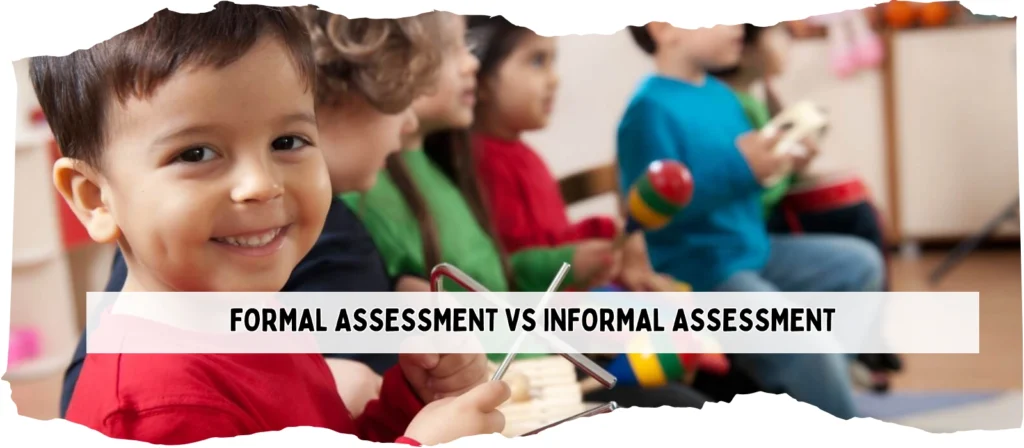
Challenges and Limitations: Formal vs Informal Assessments
While both formal vs informal assessment play essential roles in early childhood education, neither is without limitations. Understanding these challenges helps educators and decision-makers implement each method appropriately and avoid common pitfalls.
1) Limitations of Formal Assessment
Formal assessment, by design, emphasizes consistency and standardization. However, this strength can also be its greatest weakness. These evaluations often:
- Lack flexibility to account for individual learning styles and cultural differences
- Induce stress or anxiety in young children, especially in test-like settings
- Miss subtle developmental cues that only emerge in natural interactions
- Require time-consuming preparation and interpretation
In the ongoing formal vs informal assessment debate, educators must remain cautious about over-relying on rigid tools that might misrepresent a child’s true abilities or needs.
2) Limitations of Informal Assessment
Informal assessment excels in flexibility and contextual relevance, but that also introduces subjectivity and inconsistency. Challenges include:
- Difficulty standardizing data across different observers
- Risk of bias based on a teacher’s personal perceptions
- Limited utility for formal reporting or comparison with national benchmarks
- Potential gaps in record-keeping and documentation
This makes it essential for schools using informal assessment to invest in professional training, consistent rubrics, and digital tools to strengthen validity and usability.
3) Balancing the Two Approaches
The tension between structure and spontaneity is at the heart of the formal vs informal assessment conversation. Schools that rely solely on formal tools may overlook meaningful, emergent learning. Conversely, institutions that depend only on informal methods may lack the standardized data needed for external reporting or curriculum evaluation.
The ideal solution is to implement a dual assessment framework—one that integrates both formal and informal assessments into everyday teaching. This strategy helps schools:
- Maintain educational accountability
- Support individualized instruction
- Promote equity and inclusiveness in learning evaluation
In a well-designed early childhood program, formal vs informal assessment is not a competition, but a complementary system that ensures every child’s development is accurately supported and celebrated.
How to Balance Formal and Informal Assessment in Real Practice
Achieving the right balance between formal vs informal assessment is both a science and an art. It requires strategic planning, team alignment, and an understanding of when each assessment type brings the most value. In practice, a blended assessment approach leads to more responsive teaching and more accurate evaluations of a child’s learning journey.
1) Begin with Purposeful Planning
Educators should start each term by outlining clear assessment goals. What do you want to understand about your students? Which skills need to be tracked formally for reporting? Which behaviors or developmental markers are better suited to informal observation? Mapping out your intentions ensures that both formal and informal assessment tools serve a unified purpose.
2) Schedule and Integrate Both Assessment Types
A successful dual system combines scheduled formal assessments—such as developmental checklists or term evaluations—with ongoing informal observations. Teachers can plan specific assessment windows while leaving space in the day for spontaneous insights. This prevents over-testing and builds in moments for authentic observation.
3) Use Technology to Bridge the Gap
Digital platforms like learning management systems or assessment apps help educators document informal assessments in real-time and align them with formal evaluation criteria. This streamlines communication with families, supports team collaboration, and helps administrators track both forms of assessment efficiently.
Formal vs informal assessment need not be siloed—technology now enables real integration across data sources, making every observation count.
4) Train Teachers to Use Both Effectively
Professional development is key. Teachers must be trained to administer formal assessments with fidelity and observe informally with purpose. They should learn how to reflect on, analyze, and act upon both types of assessment to drive instruction and intervention.
In schools where formal vs informal assessment is seen as a unified toolset rather than separate silos, children benefit from more personalized support and consistent progress monitoring.
5) Communicate Clearly with Families
Families often understand formal assessments better than informal ones. Teachers should take time to explain how both types work together to support learning. Sharing informal observations alongside formal scores during conferences provides a richer narrative about the child’s development.
When parents see that informal assessment validates and enhances the outcomes of formal tests, they are more likely to trust the educator’s insight and become active partners in learning.
Ultimately, a balanced approach to formal vs informal assessment empowers educators to teach with insight, adapt with flexibility, and advocate with evidence—all of which directly contribute to the well-being and success of young learners.
Policy Implications: What Education Leaders Should Know
The conversation around formal vs informal assessment extends beyond classrooms—into the realm of educational leadership and policy-making. For school administrators, curriculum planners, and government agencies, understanding how these assessment types influence system-wide outcomes is crucial for effective planning and accountability.
1) Formal Assessment for Standardization and Compliance
Formal assessments are often mandated by regional or national authorities to ensure uniform standards across educational institutions. These tools provide benchmarks that can inform public reporting, policy adjustments, and funding decisions. In the context of formal vs informal assessment, formal tools are especially valued in:
- Accreditation and quality rating systems
- Teacher evaluation frameworks
- Special education placement
- Longitudinal tracking of school readiness or literacy
Education leaders should leverage formal assessments not just for compliance, but as part of a broader strategic vision. These assessments serve as touchstones for evaluating equity, inclusiveness, and effectiveness in early childhood programming.
2) Informal Assessment for Community-Based and Holistic Policy
Informal assessment, although less recognized in traditional policy circles, plays a key role in shaping inclusive, culturally responsive educational systems. Community-led schools and alternative early childhood models often use informal tools to adapt to local values, languages, and family dynamics.
In balancing formal vs informal assessment, policymakers must support models that value narrative feedback, teacher reflection, and parental input. Investment in educator training and documentation tools can enhance the policy relevance of informal assessment data.
3) Integrating Assessment Frameworks into Policy Design
Progressive education systems recognize that formal vs informal assessment should not be viewed in opposition. Forward-thinking policies blend both into assessment frameworks that:
- Include observational data in state-level reports
- Fund both digital platforms and professional learning
- Encourage schools to share qualitative evidence alongside test scores
This integration enriches the policy dialogue with nuanced insights into early development that numbers alone can’t provide. As data-informed policy continues to evolve, decision-makers must view both assessment types as co-pilots for driving quality improvement.
4) Advocating Equity through Blended Assessment
In a global education environment, formal vs informal assessment plays a vital role in promoting educational equity. Formal tools help ensure all students are evaluated under similar standards. Informal tools allow space for individual voice, context, and lived experience.
Policy should mandate—not merely recommend—that both perspectives are captured in evaluation reports. When schools are empowered to implement both formal and informal assessments with equal emphasis, the result is a more equitable and inclusive system.
By embracing a dual-assessment mindset, policy leaders send a clear message: early childhood education isn’t about either data or relationships—it’s about both. And when formal vs informal assessment are elevated together in policy, every child benefits.
Role of Assessment in Supporting Child Development
At its core, every assessment in early childhood education—whether formal or informal—is a tool for enhancing child development. The real value of formal vs informal assessment lies in how effectively each supports the holistic growth of the child, from social-emotional skills to cognitive and physical milestones.
1) Individualized Learning Pathways
Formal vs informal assessment, when used together, provides a rich tapestry of data that allows educators to customize learning plans. Formal assessments pinpoint specific academic gaps or strengths. Informal assessments reveal learning styles, interests, and emotional readiness. This combined view enables teachers to create truly individualized education plans that support every aspect of a child’s development.
2) Encouraging Developmentally Appropriate Practices
Assessment informs educators whether their instructional practices are aligned with the developmental needs of their students. A well-rounded approach—balancing formal vs informal assessment—helps ensure that teaching remains age-appropriate, engaging, and effective. It also prevents the premature academic pressure that can arise from overusing standardized tests in early years.
3) Strengthening the Whole-Child Framework
Formal vs informal assessment plays a critical role in the whole-child approach to education. Formal tools provide measurable benchmarks in language, math, and literacy. Informal tools help track personal traits like empathy, cooperation, and curiosity. When educators integrate both, they are better equipped to nurture a child’s cognitive, emotional, social, and physical development.
4) Monitoring Long-Term Progress and Readiness
Kindergarten is not the endpoint—it’s the foundation. Formal vs informal assessment provides educators and families with the insights needed to determine school readiness and long-term progress. Are children developing the executive functioning skills needed for primary school? Are they socially confident and emotionally regulated? Using both assessment types together answers these questions comprehensively.
In sum, formal vs informal assessment is not just about evaluating what a child knows, but about understanding how that child is growing. With the right balance, educators can support each child in becoming not only a successful learner—but a healthy, confident, and curious human being.
Conclusion
Formal vs informal assessment is not a question of “which is better” but rather “how can they work together.” By integrating structured metrics with rich observational insights, educators, administrators, and parents can form a complete picture of each child’s unique learning path.
At XIHA Furniture, we believe quality learning environments start with understanding children. That’s why we support kindergartens with not only safe and engaging furniture, but also insights that help you apply the best of formal and informal assessments.
Together, we build the future—child by child.

